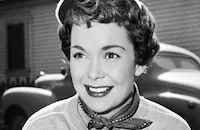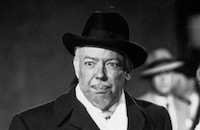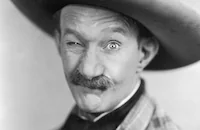Here Comes the Groom

Brief Synopsis
Cast & Crew
Frank Capra
Bing Crosby
Jane Wyman
Alexis Smith
Franchot Tone
James Barton
Film Details
Technical Specs

Synopsis
Peter Garvey, an easygoing overseas newspaper reporter for The Boston Morning Express , receives a call from his editor, George Degnan, recalling him from his post in Paris, where he has been for three years, writing articles about war orphans. George tells Pete that no one is interested in war orphans anymore, prompting Pete to recount the orphans' dire situation. George, desperate to get Pete out of Paris, offers to transfer him to the latest "hot spot," the Far East. Pete, seeing a new challenge, agrees to go, despite his great affection for the children of the orphanage at which he lives. That same day, Robert Dulac, a twelve-year-old French orphan who has "adopted" Pete as his father, runs off when a wealthy American couple arrives to adopt him. Pete, discovering that the husband is a famous symphony conductor, introduces them to Theresa, an older girl who sings opera, and despite her blindness, the couple adopts her. After he breaks the news to Bobby that he is leaving Paris, Pete receives a phonograph record from his longtime fiancée and childhood sweetheart, Emmadel "Emmy" Jones, informing him that she is tired of waiting for him and wants to get married and have children. Seeing an opportunity to adopt Bobby, Pete wires Emmy that he is coming home to marry her, and is bringing "a surprise" with him. Pete's return to America is delayed while he obtains the necessary documents to take Bobby to America, and is postponed again when Bobby refuses to go without Suzi, the little girl he found during the war and now "owns." When Pete, Bobby and Suzi finally arrive in America, several weeks late, Pete discovers that Emmy has once more tired of waiting for him and has become engaged to her boss, Wilbur Stanley, a Boston blue blood and real estate tycoon worth forty million dollars. To further complicate matters, Emmy is getting married that Saturday, the same day that Pete must be married to prevent Bobby and Suzi's being sent back to France. Pete tricks Emmy into leasing him one of Wilbur's previously rented houses and stages a news event, claiming he is a victim of "corporate greed." When Wilbur shows up to settle the matter, Pete is startled to find that Wilbur is not the old man he thought, but Pete's equal, if not superior, in every way. Pete had hoped to blackmail Wilbur into allowing him to stay in the gate house at his vast estate, but Wilbur, learning who Pete really is, readily agrees, hoping to be assured of Emmy's true affection. The two men make a bargain to allow each other to test Emmy's love for them, without getting in the other's way. At the Stanley estate, Pete meets Winifred Stanley, Wilbur's "kissing cousin," who has secretly loved Wilbur for years. At first Pete hopes to make Emmy jealous by claiming his affection for Winifred, but quickly changes tactics by trying to "Jonesify" the staid Winifred. Pete successfully teaches Winifred how to wrestle, laugh heartily and provoke wolf whistles with a seductive walk. At the wedding rehearsal, after Winifred takes Emmy's place and proclaims her love for Wilbur, the two women get into a wrestling match, and Emmy admits she is "no lady." Much to Pete's chagrin, Wilbur is not dismayed, but instead tells Emmy that he is glad she is acting like herself again rather than trying too hard to be a lady. Thinking he has won, Wilbur arranges to adopt Bobby and Suzi after marrying Emmy, but the wedding is disrupted when an FBI agent arrives with Pete in tow, claiming he tried to abduct the children. Emmy, not wanting Pete to lose the children, asks Wilbur to intercede, which he does by having Pete take his place at the altar. After the ceremony, Pete confesses to Wilbur that the FBI agent was really a fellow reporter, but the genial Wilbur congratulates him on his ingenuity. Pete instructs Wilbur to take good care of Winifred, and Wilbur, finally realizing how much he cares for Winifred, happily asks her if she wants to wrestle. Emmy and Pete then drive off with their new family, and Emmy cheerfully reveals that she knew the FBI agent was a fake.

Director

Frank Capra
Cast

Bing Crosby

Jane Wyman

Alexis Smith

Franchot Tone

James Barton

Robert Keith
Jacques Gencel
Beverly Washburn

Connie Gilchrist

Walter Catlett

Alan Reed

Minna Gombell

Howard Freeman
Maidel Turner

H. B. Warner

Nicholas Joy

Ian Wolfe

Ellen Corby

James Burke

Irving Bacon
Ted Thorpe
Art Baker

Anna Maria Alberghetti

Dorothy Lamour
Frank Fontaine

Louis Armstrong

Phil Harris
Cass Daley
Laura Elliott
Marion Gray
Chris Appel
Odette Myrtil
Michele Lange
Charles Sullivan
Ed Randolph
Jack Roberts

Charles Halton
Neal Dodd

Charles Lane
Gerry Ganzer
Nancy Clark
Rosalee Calvert
Lynn Starr
Diane Garrett
Sue Casey
Ann Beck
Mimi Berry
Peter Roman
Fred Fichter
Vernon Lenhardt
Frank Tarallo
Maurice Martinoli
Christian Pasques
Alain Cavania
Claude Guy
Anthony Mazola
Martine Henrard
Peter Troiekouroff
Angos Perez
Fred Cuellar
Suzanne Orrick
Andree Guy
Lucia Tarallo
Marie Françoise Brun-cottan
Giovanna Piazza
Jocelyn Lachanne
Christel Pelka
Connie Russo
Patricia Russo
Jean Carnera
Mae Louise Gentry
Ralph Brooks
Ivan H. Browning
George Ford
Robert Rich
Cosmo Sardo
Warren Mace
Joe Gilbert
Charles Campbell
Herschel Graham
Les Clark
Adeline De Walt Reynolds
Lyle L. Moraine
Joe Byran
Bill Meader
Josephine Whittell
Gail Bonney
Frances Sanford
Connie Conrad
Betty Corner
Bert Stevens
Stanley W. Orr
Louis Mercier
Jack Roberts
Les Clark
Lorraine Clark
Marie Thomas
Andre Charlot
Douglas Wright
Ralph Montgomery
June Earle
June Glory
Lola Kendrick
Mary Benoit
Evelyn Cedar
Betty Seland
Kathryn Towne
Charmienne Harker

Bess Flowers

James Finlayson
John "skins" Miller
June Hedin
Audrey Washburn
Isabel Cushin
Patti Bell
Gwenn Fields
Karen Kester
Donald Kerr
Eddie Borden
Warren Shannon
Timmie Hawkins
Jimmie Hawkins
Judy Nugent
Carol Lou Nugent

Carl Dean Switzer
Joe Recht
Patty Lou Arden
Paul Bradley
Nita M. Pike
Charles Evans
Howard Joslin
Walter Mcgrail
Four Hits And A Miss
James A. Cornell
Mike P. Donovan
Julia Faye
Franklyn Farnum
Hazel Boyne
Frank Hagney
Jerry James
Florence Clayton
Beulah Christian
Dolly Jarvis
Estelle Etterre
Don Dunning
Anne M. Kunde
Hans Moebus
Stanley Mckay
Almira Sessions

J. Farrell Macdonald
Crew
Irving Asher
George Barnes
Arthur S. Black
Harry Caplan
Frank Capra
Hoagy Carmichael
Geraldine Cole
Myles Connolly
John Cope
Wanda Crellin
Wanda Crellin
Farciot Edouart
Ray Evans
Edith Head
Earl Hedrick
Ellsworth Hoagland
Gordon Jennings
Emile Kuri
Paul Lerpae
Joseph J. Lilley
Jay Livingston
Johnny Mercer
Harry Mills
Clara Mortensen
Clara Mortenson
Liam O'brien
Liam O'brien
Charles O'curran
Hal Pereira
Francesco Maria Piave
Robert Riskin
Van Cleave
Virginia Van Upp
Giuseppe Verdi
James Vincent
Wally Westmore

Film Details
Technical Specs

Award Wins
Best Song
Award Nominations
Best Writing, Screenplay
Articles
Here Comes the Groom
In his autobiography, The Name Above the Title, Frank Capra writes "Here Comes the Groom was noteworthy to me because of a song, the launching of a fourteen-year-old Italian girl's career, and the charming chemistry that developed from the performances of Bing Crosby and Jane Wyman." The song was "In the Cool, Cool, Cool of the Evening," written by Johnny Mercer and Hoagy Carmichael for Betty Hutton to sing in a musical biography of silent star Mabel Normand. That film was never made, and the bouncy song had been languishing in Paramount's vaults. Capra and Crosby both liked the song, and the director dreamed up a delightfully offbeat production number around it. Crosby and Wyman began the song in an upstairs office, continued down the hall to the elevator, into the lobby, out of the building, and down the street. To keep the spontaneity, the number was filmed live, with the orchestra playing in a nearby soundstage, and Crosby and Wyman listening through tiny transmitters in their ears, and singing live. Capra claimed in his autobiography that it was done in one take. The tune won an Academy Award as best song.
Jane Wyman, who had begun her career as a chorus girl and had a fine singing voice, was up to the task of singing with Crosby. She had been playing drama recently, and had won an Oscar® for her performance in Johnny Belinda (1948), but proved an excellent musical and romantic onscreen partner for Crosby. They followed this pairing with another Paramount musical together, Just for You (1952).
Wyman wasn't the only co-star who was playing against type in Here Comes the Groom. Tall, elegant Alexis Smith usually played icy upper-class types in dramatic films. She played a prominent socialite in Here Comes the Groom as well, but with a twist. As Franchot Tone's distant cousin, who's secretly in love with him, Smith learns to loosen up (with Crosby's help), and turns in a lively comic performance that culminates in a rowdy cat fight with Wyman's character.
Besides "In the Cool, Cool, Cool of the Evening," there were two other standout musical numbers in Here Comes the Groom. One of them features the young Italian girl Capra mentioned in his autobiography, Anna Maria Alberghetti. Early in the film, playing a blind orphan, Alberghetti sings the aria "Caro Nome," from Verdi's opera, Rigoletto. Although Here Comes the Groom's credits read "Introducing Anna Maria Alberghetti," she had actually appeared in the film version of Gian Carlo Menotti's opera, The Medium (1951). But that film was little seen, and Here Comes the Groom was the movie that really started her film career. The other outstanding musical number in Here Comes the Groom is "Misto Cristofo Columbo," an all-star jam session with Crosby and guest stars Dorothy Lamour, Louis Armstrong, and Phil Harris, all playing USO entertainers.
Capra, who had begun his career in silent films, also gave cameos and bit parts in Here Comes the Groom to several silent screen actors, including Franklyn Farnum, Julia Faye, and Mack Sennett veterans Chester Conklin and Jimmy Finlayson. Playing a larger role as one of Tone's stuffy relatives was H.B. Warner, who had played Christ in The King of Kings (1927), and had supporting roles in three previous Capra films, including the grieving pharmacist in It's a Wonderful Life (1946).
Here Comes the Groom was a hit with critics and with audiences. The film also received another Oscar® nomination, for its screenplay. But Capra was no longer affiliated with any studio, and with no film offers forthcoming, he turned to television, directing four one-hour science programs. He would make only two more feature films, A Hole in the Head (1959) and Pocketful of Miracles (1961) before retiring.
Director: Frank Capra
Producer: Frank Capra
Screenplay: Virginia Van Upp, Liam O'Brien, Myles Connolly, from a story by Robert Riskin & Liam O'Brien
Cinematography: George Barnes
Editor: Ellsworth Hoagland
Costume Design: Edith Head
Art Direction: Hal Pereira, Earl Hedrick
Music: songs by Hoagy Carmichael & Johnny Mercer, Jay Livingston & Ray Evans
Principal Cast: Bing Crosby (Peter Garvey), Jane Wyman (Emmadel Jones), Alexis Smith (Winifred Stanley), Franchot Tone (Wilbur Stanley), James Barton (Pa Jones), Robert Keith (George Degnan), Jacques Gencel (Robert Dulac), Beverly Washburn (Suzi).
BW-113m.
by Margarita Landazuri

Here Comes the Groom
Quotes
No, I'm not going to live Ma's life all over again, waiting on shore for a sailor who comes to land every three years. It's like being married to a salmon!- Emmadel Jones
Shall I break your egg, Sir?- Baines
No thank you. I have me own teeth!- Pa Jones
Trivia
Notes
The working title of this film was You Belong to Me. Paramount purchased the original story from frequent Frank Capra collaborator Robert Riskin in 1949. The picture was announced in a August 14, 1950 ParNews item as a Bing Crosby vehicle, with Irving Asher producing and Richard Haydn directing. In an early treatment by Liam O'Brien and Asher, the "Emmadel" character was specifically tailored for Jean Arthur, who had starred in some of Capra's most popular 1930s films. ParNews noted that Asher, Haydn and Crosby met at the Crosby ranch in Nevada and had planned to begin production in early October 1950. On 27 Aug, however, Haydn was replaced by Capra, and Asher became the associate producer. According to Capra's autobiography, Paramount executive Y. Frank Freeman offered to release Capra, who had two pictures remaining on his Paramount contract, from his final film if he directed Here Comes the Groom. In March and April 1951 news items, Paramount officially announced that Capra was leaving the studio and dissolving Liberty Films after the completion of Here Comes the Groom. According to a March 1951 Hollywood Reporter item, The Trial, written by Virginia Van Upp, was to have been Capra's last Paramount film.
In late October 1950, pre-production filming in Boston and Gloucester, MA was completed by second units. According to ParNews, Capra set a Paramount production record when he rehearsed, pre-recorded and filmed the musical number "Misto Cristofo Columbo" in less than one day. He used three cameras simultaneously, four projection transparency machines, five microphones and three portable recording machines. Publicity materials, included in the film's copyright records, also claim that the scene in which "Pete" telephones "George" was filmed "live." Two sets-George's newspaper office and the orphanage-were equipped with two cameras, which simultaneously recorded each side of the conversation.
While the film's credits read "introducing Anna Maria Alberghetti," she had previously appeared in the 1950 film version of Gian-Carlo Menotti's opera The Medium (see AFI Catalog of Feature Films, 1941-50). Hollywood Reporter news items add Elaine Edwards and George David to the cast, but their appearance in the final film has not been confirmed. As noted in modern sources, the song "In the Cool, Cool, Cool of the Evening" was written for Betty Hutton. Hutton, for whom contemporary sources claim Here Comes the Groom was originally purchased, was to perform the song in The Mack Sennett Girl, an unproduced biography of silent film star Mabel Normand. While the song is heard throughout Here Comes the Groom, its main production number, according to Capra's autobiography, was filmed in one take with no pre-recording. The orchestra played on a music stage while Crosby and Jane Wyman sang and danced on various sound stages, listening to the orchestra through tiny radios equipped with antenna loops. "In the Cool, Cool, Cool of the Evening" received an Academy Award for Best Song of 1951.
On the weekend of July 30, 1951, the film had its world premiere in the small town of Elko, NV; Crosby, Elko's honorary mayor, owned a 25,000 acre horse ranch sixty miles outside of town. In addition to its Academy Award for Best Song, the film also received a nomination for Best Writing-Motion Picture Story (Robert Riskin and Liam O'Brien). In late September 1951, shortly after the film's national release, Franchot Tone was involved in a highly publicized scuffle with actor Tom Neal over actress Barbara Payton. For more information, please consult the entry below for Lady in the Iron Mask. Here Comes the Groom was Capra's last feature film until the 1959 United Artists release A Hole in the Head (see below).
On September 15, 1952, Wyman reprised her role in a Lux Radio Theatre version of the story. Fred MacMurray co-starred and sang "In the Cool, Cool, Cool of the Evening." On March 1, 1956, Robert Sterling and Pat Crowley starred in a Lux Video Theatre version, directed by Norman Morgan and broadcast on the NBC television network.














